Crown molding isn’t essential to the function of a home, but it’s certainly nice to have. It adds style and character without making a space look overdone or cluttered. There are endless choices to match any design theme or budget.
“This is a small touch that can make a world of difference in a room — regardless of whether you are considering a colonial style or something more modern,” says Kevin Busch, vice president of operations for Mr. Handyman, a Neighborly company.
“In terms of enhancing the architectural style of your home’s interior, crown molding also comes in as one of the less expensive options.”
Whether you’re thinking about adding crown molding or your home already has it, here’s what you need to know.
Crown Molding vs. Molding
“Molding refers to any trim in a building; it can occur at the shelves, roof, chair rail, window frame, picture rail, and outside the building,” says Ray Charles, woodworking expert and founder of Household Air. “Crown molding, on the other hand, refers specifically to the molding that happens at the ceiling level.”
Crown molding adorns the top of a wall in the same way a crown adorns the top of a head. It hides the seam where the wall and ceiling meet. Crown molding often matches the other molding in the room and cabinetry details.
Types of crown molding
Here are nine of the most common crown molding materials. Which one you choose will depend primarily on location and budget (more on that later):
- Wood;
- Flexible;
- Polyurethane;
- Metal;
- Composite;
- Medium Density Fiberboard (MDF);
- Vinyl;
- Polystyrene;
- PVC.
Crown molding styles
There are lots of styles, allowing homeowners and designers to achieve any look. Wider pieces of molding can incorporate several elements in the same piece. Here are six common styles:
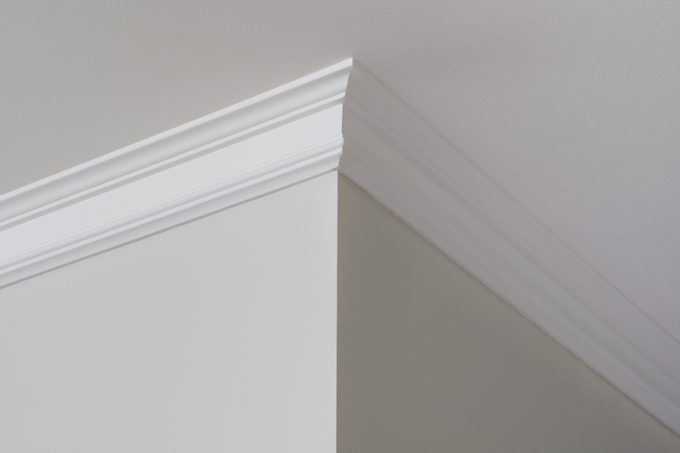
Step crown molding features a simple and timeless design. “It includes series of flat shapes with varying heights or widths,” says Charles.
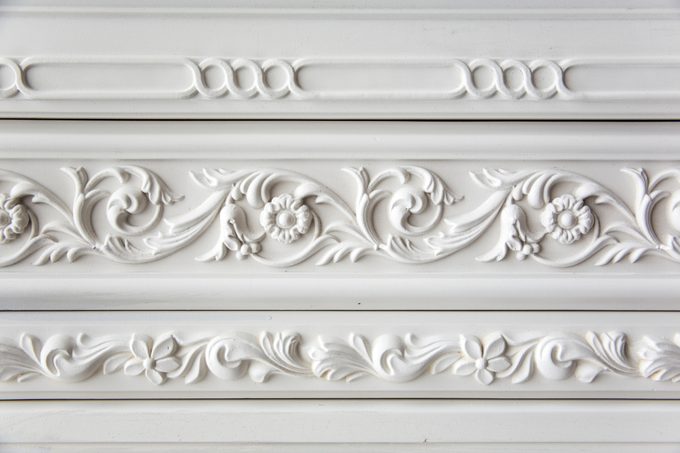
Leafy crown molding looks exactly how it sounds, with foliage-inspired patterns.
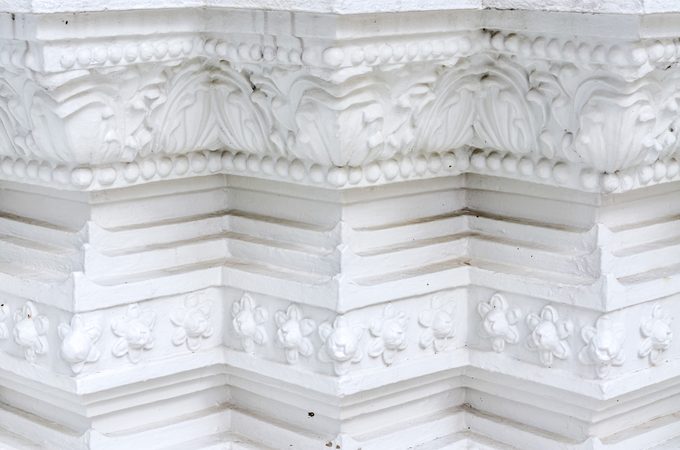
Bead crown molding “uses small spheres arranged in unique patterns like rows or shapes,” says Charles. These are usually incorporated into other styles.
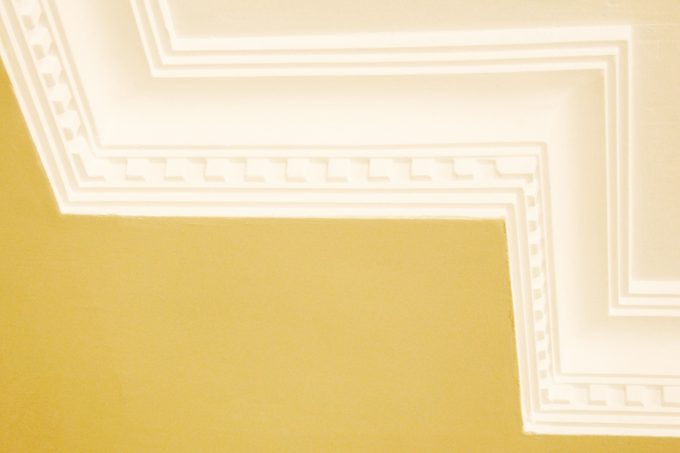
Dentils “uses a tooth-shaped block to create a beautiful continuous pattern,” Charles says. It really does resemble a toothy grin.
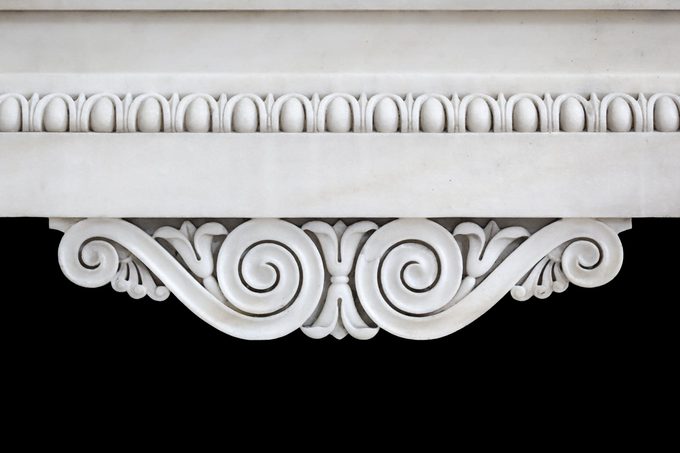
Egg and dart crown molding has intricate egg-shaped carvings with dividers, or darts. These set it apart from bead styles, which have spherical carvings side by side.
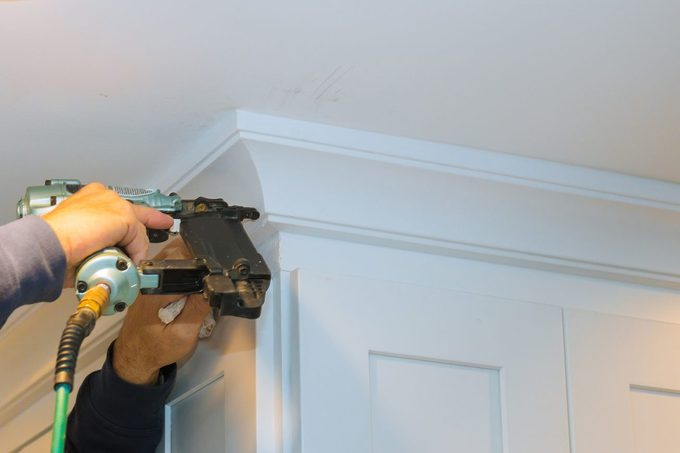
Cove crown molding, not seen as often as the others, “is used at corners or curves and takes a concave shape before changing direction,” Charles says.
How much does crown molding cost?
The cost varies significantly based on style and material, room size, region and more. Installation is also a factor. Best to talk to a professional about your home’s specifications.
Charles says in the U.S., crown molding starts at from $6 to $20 per linear foot. The total typical ranges $566 to $1,862, according to HomeAdvisor. Wood and plaster cost the most. Charles says composite materials like polyurethane, PVC, and polystyrene are the cheapest.
Benefits of Crown Molding
There are many benefits of crown molding, mostly related to building aesthetics.
First, crown molding hides the seam between the walls and the ceiling. When left bare, that transition can look ugly, and it’s a common area to see painting mistakes. Crown molding covers all of that. Crown molding can also be installed after the fact to “to cover the gaps that appear between the ceiling and wall due to contraction and expansion,” Charles says.
Second, crown molding adds a personal touch to otherwise blank walls. “Molding is one the most decorative and permanent building arts,” says Charles. “In short, unlike other décor like chandeliers, paintings, picture rails, lights, and upholstery, crown molding is part of the building that remains even when building ownership changes.”
Crown molding can make a space look bigger. “It ‘lifts’ the space by the use of lines and shapes that draw the eyes upwards and create the illusion that the ceiling is higher than it actually is,” Charles says. Drawing the eye up is one of the most commonly advised ways to make a room seem bigger, much like hanging drapes near the ceiling.
Finally, finishing touches like crown molding matter when selling a house. “Owing to its ‘crowning’ aspect that brings out the overall appeal of a building, crown molding increases the value of a building,” says Charles. Tasteful crown molding and complementary paint colors make the place look newer, cleaner and more complete.
How To Choose Crown Molding
Choosing crown molding can be as difficult as choosing paint.
“Not only must you decide on a crown molding that complements the existing style of your home, but you also must choose a material,” says Busch. “A professional can help you pick both a style and material that will age gracefully along with your home.”
There are so many looks and materials that narrowing it down may seem impossible. So Charles offers some advice.
Purpose
“The expectations of the user should be the first consideration when choosing the type of molding,” Charles says. What is the molding supposed to do? Is it purely decorative? Will it cover a blemish on the wall?
“If the idea is to create harmony with other subjects in the building like flooring and fittings, MDF is the outstanding choice as it can be customized to fit existing details,” Charles says. However, cheaper materials such as PVC will work well enough to cover imperfections.
Location
Will the crown molding be indoors or outdoors? Will it be in a bathroom or another moisture-prone space? Charles recommends rubber- and plastic-based materials for crown molding exposed to moisture, such as PVC or polyurethane — not MDF or wood.
Nature of surface
In areas where adhesive doesn’t perform well, “wood and MDF, which use nails to attach them, would work,” Charles says. “If the surfaces are curved or have lots of corners, one can go with flex.”
Design
This one is pretty straightforward. The most difficult part is finding a crown molding style that matches the rest of the home. “Plaster is the best when it comes to custom designs as it can be molded to suit any style,” Charles says.
Cost
Crown molding with ornate designs or complex installation processes will cost more, so if you’re trimming a large space on a budget, exotic wood and plaster aren’t the best choices. PVC, flex and polyurethane have simpler designs, but they’re more affordable and easier to DIY.
How To Install Crown Molding
Installing crown molding isn’t an easy DIY task. It requires advanced carpentry skills, specialty tools and a second pair of hands, so it’s a good time to hire a pro. However, if you’re up to the challenge and have a friend to help, here are the recommendations from our experts.
Measuring and cutting crown molding
Precise measurements are crucial, and each piece must be planned out in advance. One wrong cut can leave an entire strip in the scrap pile. “Cutting the crown molding itself also proves challenging for amateur carpenters,” Busch says. The most basic carpentry advice — measure twice, cut once — especially applies here.
For tools, Busch recommends a coping saw and power miter saw, chalk line, hot-glue gun, rasp, drill and hammer. Some people opt to use a nail gun. The specific tools required will depend on the size and material of the molding.
Attaching the crown molding
Once all the pieces are planned, measured and cut, it’s time to attach the crown molding to the wall. This is the part where you’ll need someone to hand you pieces and help hold them in place.
“Keep in mind that you can hide minor mistakes with caulk on paintable material,” says Busch. “You cannot with stained crown molding.”
Be sure to use the right carpentry tools for your chosen crown molding. Using the wrong one can split the molding.
How to remove crown molding
It’s possible to remove crown molding, but be prepared for a mess and possibly some damage to the wall. Charles gives plaster as an example. Since plaster molding binds to the wall and ceiling, it often takes parts of the underlying surface with it when removed, leaving dents and chips in its wake.
Other types of crown molding are easier. “Adhesive-based molding can be removed by using thinners or liquids that soften the glue,” says Charles. “MDF and wood, if attached using nails, can be lifted off using special hammers or crowbars.”
When in doubt, consult a pro. If you’re hiring someone to replace your molding, they’ll likely remove the existing materials for you.
Article source here: What Is Crown Molding?


No comments:
Post a Comment